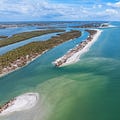Hurricane Cuts Two Navigable Inlets: Is Nature Teaching Florida a Lesson? (Video)
Residents Celebrate as Others Ponder Creating More of Them

Update at 5:35 p.m: Fixed for errors pointed out by reader Gerard Ezcurra of Siesta Key, whom I owe a beer. The initial article conflated Milton Pass and Midnight Pass.
There are two “new” navigable inlets on the Southwest Florida coast.
One is being called Milton Pass, and it created an inlet through Manasota Key in Charlotte County, giving boaters another way to transit from the ocean to Lemon Bay. Meteorologist Matt Devitt of Wink News said that Hurricane Helene started the opening, and Hurricane Milton finished it. The pass is about 8 to 10 feet deep.
Watch a video at bottom showing the Milton Pass shot from a boat. Now boats are able to transit freely from Little Sarasota Bay to the Gulf of Mexico.
Milton, which made landfall on the West Coast on October 9 as a Category 3 storm, also reopened Midnight Pass about 20 miles north in Sarasota County. It divides Siesta Key from Casey Key and now allows boats to transit freely from Little Sarasota Bay to the Gulf of Mexico.
This essay was originally published by The Space Coast Rocket news outlet under the headline “Should Brevard Take a Page from Midnight Pass? Debating New Inlets as a Lifeline for the Indian River Lagoon.” It is reprinted here with permission.
Midnight Pass, a natural inlet located between Siesta Key and Casey Key on Florida’s Gulf Coast, has a complex history marked by human intervention and natural processes. Originally a dynamic waterway that facilitated the exchange of tidal flows between the Gulf of Mexico and Little Sarasota Bay, the pass was closed in 1983 due to concerns about erosion threatening nearby properties.
This closure, achieved by filling the inlet with sand, effectively cut off the bay from regular tidal flushing, leading to decades of degraded water quality and a loss of critical habitat for marine life
Since the closure, residents and environmental advocates have campaigned persistently to reopen Midnight Pass. These efforts have included lobbying Sarasota County officials, engaging with environmental organizations, and even wielding shovels to try and restore some water flow by hand. The Sarasota County Commission has taken steps over the years to explore legislative solutions for reopening the pass, but bureaucratic and legal hurdles have repeatedly stymied progress. Despite these setbacks, the local community’s desire to see the inlet restored has never waned .
Nature intervened dramatically in 2024, when back-to-back hurricanes—Helene and Milton—brought storm surges powerful enough to carve a new path through Midnight Pass. Helene initially opened a narrow channel, and three weeks later, Hurricane Milton’s stronger surge widened the breach, allowing boats to navigate between the bay and the gulf for the first time in four decades.
Residents celebrated this unexpected gift, viewing it as a victory for the ecosystem and a testament to nature’s resilience. Despite the reopening, the inlet’s long-term viability remains uncertain, as shifting sands and tidal flows may cause it to close again without human intervention, such as dredging .
In contrast to Midnight Pass, the Indian River Lagoon on Florida’s East Coast has suffered its own set of ecological challenges. Known as one of North America’s most biologically diverse estuaries, the lagoon has faced severe issues in recent decades, including nutrient pollution, harmful algal blooms, fish kills, and the loss of seagrass beds. These problems have been exacerbated by a lack of natural water exchange, as the lagoon is largely cut off from the open ocean except for a few inlets .
Proposals to cut new inlets from the Atlantic Ocean into the lagoon have emerged as potential solutions to restore the estuary’s health. Advocates argue that new inlets could help flush out pollutants, improve water circulation, and increase oxygen levels, much like the reopening of Midnight Pass has done for Little Sarasota Bay. However, such measures come with risks.
New inlets could disrupt existing ecosystems, alter salinity levels, affect local fisheries, and cause sediment buildup in unintended areas. There is also the concern that the benefits may be temporary, requiring ongoing management and potential environmental trade-offs .
The experiences at Midnight Pass and ongoing debates over the Indian River Lagoon highlight the challenges of balancing human interests with natural processes. While cutting new inlets could offer a lifeline to the struggling lagoon, it is crucial to approach such projects with careful consideration of their ecological impacts, just as the residents of Sarasota have learned through their decades-long struggle to reopen Midnight Pass.


Looks good now, Peter. Glad to hear both of these passes have been opened. Being a life long resident of Bradenton I’m well aware of the Midnight Pass saga. Milton Pass may be a good option for us now. Stump Pass is tight & always changing, therefore requires local knowledge. This has made Stump Pass a no go for me in our current boat.
That looks like Stump Pass in the background, but the new pass would be through Englewood Beach. Not Siesta Key.